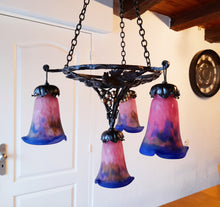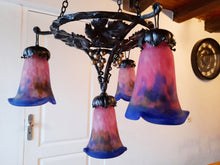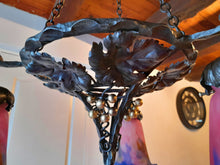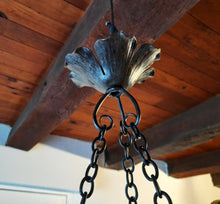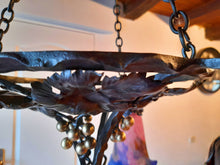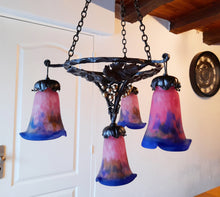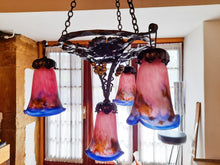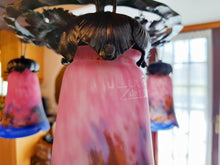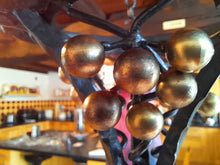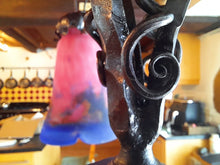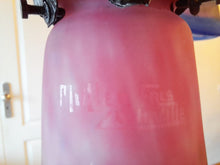
Art Nouveaux Chandelier by Muller Frères of Lunneville, 4 Shades, Hand Made, Perfect Condition
An absolutely stunning chandelier created by the famous Muller Brothers of Lunnevile in around 1900. Every detail is exquisite and a perfect example of the Art Nouveaux period characterized by its use of sinuous, organic lines and flowing curves.
The design is of vines leaves with 18 grapes. The chandelier itself is hand made from wrought iron while the grapes are of brass and each one has been hand turned and tapped.
Each of the beautiful shades is perfect and bear the etched mark of the Muller brothers. The shades measure 14 x 12 centimetres and are all hand made. In France, “pâte de verre” is the process of putting together in a mould some pieces of cold solid glass, whatever the sizes of the pieces (powder, smaller or bigger particles), and heating until you obtain your final object. It takes great skill to create matching shades and particularly at the time that these shades were made.
Due to the process no two shades are ever exactly identical which gives them their charm.
They glow beautifully when lit with a soft diffused light.
It also has its original bulb fittings which are also in excellent condition. It is not wired as the original wiring had long since deteriorated and, in any event, would not be up to modern standards. However, this wonderful chandelier will be supplied with antique style black cloth covered two core wire to enable it to be re-wired to the original specification. The whole chandelier measures 84 centimetres from top to bottom and is 40 centimetres at its widest point.
This beautiful piece will ship by carrier as standard and full international tracking. Shipping is included in the price so there will be no surprises at checkout. Please add your telephone number with your order as the carrier will require it.
The Muller brothers trained at the most famous glass factories in France, Saint Louis factories in Bitche, at Emile Gallé in Nancy, Daum, Sèvres, Baccarat and Meisenthal, thus accumulating a lot of experience.
In 1895, Henri arrived in Lunéville after leaving Emile Gallé's factory and created his own engraving workshop (probably rue Saint Anne). Désiré followed him and Eugène joined him in 1904. It is said that glass production is very close to that of Emile Gallé or the Daum Brothers.
They were able to take advantage of the intense artistic activity of the city and the spectacular craze for decorative arts at the beginning of the 20th century, by favouring the naturalist repertoire dear to Nancy's Art Nouveau. The Muller Brothers produced original pieces of great technical and decorative sophistication, capable of demonstrating the originality and excellence of Lorraine glass production during this period. In 1898, they won the gold medal at the Dijon exhibition. In 1900, a new award was given to them at the Universal Exhibition in Paris.
Wheel engraving and carburizing with silver or copper were particularly well mastered by the Muller brothers. They were able to create parts with 7 layers of glass. In 1911, they won the silver medal at the international exhibition in Turin.













